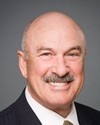Thank you, sir.
Mr. Chair, members of the committee, thank you for the invitation to appear in front of you today. I'm happy to be here to provide you with an update on Canada's military contribution to the relief efforts in the Philippines in the wake of typhoon Haiyan.
As you know, the largest typhoon ever recorded struck the Philippines on the eighth of November causing massive devastation throughout a wide portion of the country.
The storm killed more than 5,000 people, destroyed more than 2 million homes and affected 15 million individuals. Despite its best efforts and preparations, the Philippine government was quickly overwhelmed by the sheer scale of the disaster, and it became clear it would need help from the international community.
Immediately after the typhoon struck, Canada mounted a rapid and comprehensive humanitarian response, which was led and coordinated by the Department of Foreign Affairs, Trade and Development, under the framework of the Government of Canada standard operating procedures in response to natural disasters abroad. My colleagues with me today from Foreign Affairs can certainly answer any questions on these broader efforts.
On the 11th of November the Minister of Foreign Affairs, John Baird, announced that the Prime Minister had authorized the deployment of the disaster assistance response team, DART, as part of the whole-of-government response. The first elements of that team departed less than an hour later.
As one element of Canada's civilian-led response tool kit, the DART provides Canada with a rapid response capability to disaster and humanitarian crises upon request of an affected country. The team is a scalable unit made up of a wide spectrum of capabilities that range from urban search and rescue, military engineers, and emergency medical teams, to a helicopter airlift unit.
Our DART members provide rapid assistance in close cooperation with national and local authorities and our humanitarian partners to address immediate relief needs after an emergency or disaster. They seek to prevent the rapid onset of any secondary effects of a disaster, such as disease or malnutrition, and act as a stabilization measure to bridge the gap until civilian actors are in a position to provide longer-term assistance.
On November 10 the interdepartmental strategic support team, ISST, an eight-member group led by DFATD and supported by the commanding officer of the DART, departed Canada via CC-144 Challenger aircraft. By the 13th they were already liaising with Philippine federal and local authorities and conducting reconnaissance to determine where the DART could best be used. The rapid establishment of multilateral links was essential to ensuring Canada brought the right aid to the right place at the right time.
It was quickly determined that Canada's support was needed in the north of Panay Island in the western Visayas region of the Philippines, an area that was directly in the path of the typhoon but had yet to receive any assistance. The region was hard hit, and the need for clean water, medical assistance, road clearance, and infrastructure repair was great. Moreover, the rugged nature of the region and that damaged infrastructure meant capabilities provided by helicopters would be immensely useful.
Through the use of our C-17 Globemaster and the CC-150 Polaris aircraft, the Canadian Armed Forces quickly established an air bridge that transported personnel and vital equipment, including three Griffon helicopters, engineering vehicles, medical supplies, and large-scale water purification systems to the people of the Philippines. Additionally, the CC-144 Challenger conducted aerial reconnaissance and intratheatre airlift tasks.
By November 15, the members of the Disaster Assistance Response Team—DART—had established their headquarters in Roxas City, on the northern tip of Panay Island. From the outset, civilian humanitarian and political experts from DFATD were embedded with the DART to ensure appropriate coordination mechanisms were put in place. The engineering personnel immediately began clearing key roadways, while medical teams started seeing patients the very next day.
Over the coming days, the team grew quickly to over 300 personnel, branching out across the region to rapidly provide help to those in the greatest need. The helicopters began flying missions, which meant that vital aid and medical care could be brought to the more isolated areas of northern Panay, while our engineering teams continued to clear roadways and effect repairs to critical infrastructure, notably by repairing a number of emergency generators for key installations such as hospitals.
The Challenger provided intra-theatre airlift and assisted in the movement of numerous VIPs, such as the deputy secretary-general of the United Nations, enabling the assessment of the situation by international organizations. Of particular significance, the Challenger conducted the airlift of a 12-year-old with a severely infected leg from Ormoc to Manila, enabling rapid medical attention, saving her life and her leg.
On November 24, the commanding officer of the DART declared full operational capability, and the team was working hard across all lines of operation. By this time, two reverse osmosis water-processing units, ROPUs, were operating and had already distributed 7,000 litres of water. In addition, three Griffon helicopters were in theatre and were not only transporting mobile medical teams but were helping the World Food Programme get food aid to isolated communities on Panay.
As the mission progressed, engineers assisted non-governmental organizations with the construction of an emergency shelter to house those displaced by a large oil spill caused by the storm. By November 27, there were 20 Filipino Canadian military liaison officers deployed across the DART's area of operations to help facilitate the coordination of humanitarian assistance efforts.
Throughout, the DART worked closely with the Government of the Philippines, the Armed Forces of the Philippines, and local government authorities, as well as our military allies once they arrived in theatre, such as the Australian military and the British Royal Navy. This coordination proved essential in maximizing the DART's effect on the ground.
The DART often conducted missions hand in hand with non-governmental organizations operating in the area, which led the United Nations Office for the Coordination of Humanitarian Affairs to hail Canada's DART operation as the model for civilian military cooperation.
At this time, there are 316 Canadian Armed Forces personnel providing support in the Philippines. To date, I'm pleased to report that our personnel have distributed over 260,000 litres of water, treated over 5,100 patients, and helped non-governmental organizations deliver over 121,000 pounds of emergency food aid.
Canada's three deployed Griffon helicopters have flown more than 140 flights in support of DART operations.
The DART's engineering troops have cleared 122 kilometres of road, repaired eight major generators, and assisted in the repair and construction of emergency shelters and temporary storage facilities for non-governmental organizations.
Finally, before returning to DART, our Challenger jet flew 60 missions in support of these DART efforts.
This rapid delivery of effects is a product of careful preparation, maintenance of readiness and close liaison with our other governmental partners. Our detailed contingency plans have enabled this from the beginning, ensuring that we worked closely with the whole of government and were ready with numerous options to support the Government of Canada's response to this crisis in the shortest possible time.
To assist in the work of this committee, I've provided a presentation that includes additional information and details for your review.
Major-General Steven Noonan and I, as well as Leslie Norton, the director general of the international humanitarian assistance directorate, and Andrew Shore, the director of humanitarian affairs and disaster response division, would be happy to take any questions you may have.
Thank you.











